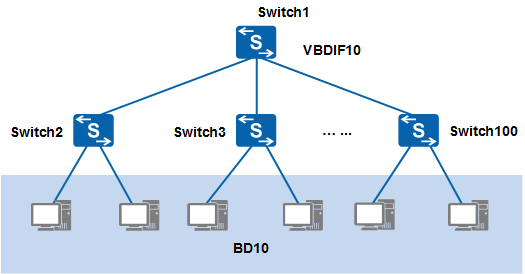arp broadcast disable (VBDIF interface view)
Function
The arp broadcast disable command disables the ARP broadcast function on a VBDIF interface.
The undo arp broadcast disable command enables the ARP broadcast function on a VBDIF interface.
By default, ARP broadcast is enabled on a VBDIF interface.
Usage Guidelines
Usage Scenario
By default, a VBDIF interface broadcasts ARP packets in a BD. However, in the large Layer 2 aggregation scenario shown in Figure 1, hosts on the user side are connected to aggregation switch 1 through switches 2-100, and the VBDIF interface is created on switch 1 as the user gateway, allowing hosts on the user side to communicate with external devices. The default ARP broadcast packet processing of the VBDIF interface can cause ARP packet flooding on the user side, which occupies large amounts of resources on the user side and affects normal user services. In addition, when a large number of ARP packets are broadcasted, the performance of switch 1 is affected.
To ensure normal user services and aggregation gateway performance in the large Layer 2 aggregation scenario, you can run this command to disable ARP broadcast on the VBDIF interface of an aggregation gateway.
Precautions
- ARP proxy scenario. After a VBDIF interface is disabled from broadcasting ARP packets, the proxy does not forward ARP request packets from a host to their destinations even if all proxy conditions are met. As a result, ARP proxy fails.
- Scenarios in which hosts send unicast packets. For example, in ping operations, ICMP request packets must be encapsulated with MAC addresses mapped to the destination IP addresses. If a host does not have ARP entries, it has to send ARP request packets to learn the MAC address mapped to the destination IP address. However, the VBDIF interface is disabled from broadcasting ARP packets, and therefore cannot send ARP request packets. Consequently, the host cannot obtain the MAC address mapped to the destination IP address, causing a ping operation failure. This problem also occurs in other scenarios in which hosts send unicast packets.
- Strict ARP learning scenarios. In a strict ARP learning scenario, a device learns MAC addresses of only ARP reply packets in response to ARP request packets that it sends. If the VBDIF interface is disabled from broadcasting ARP packets, it cannot actively send ARP request packets. As a result, strict ARP learning fails.
